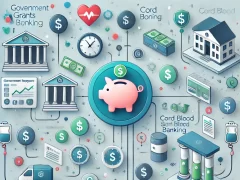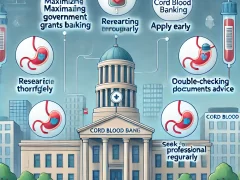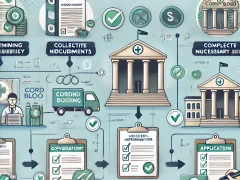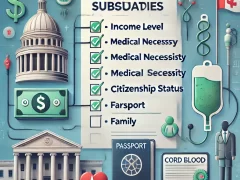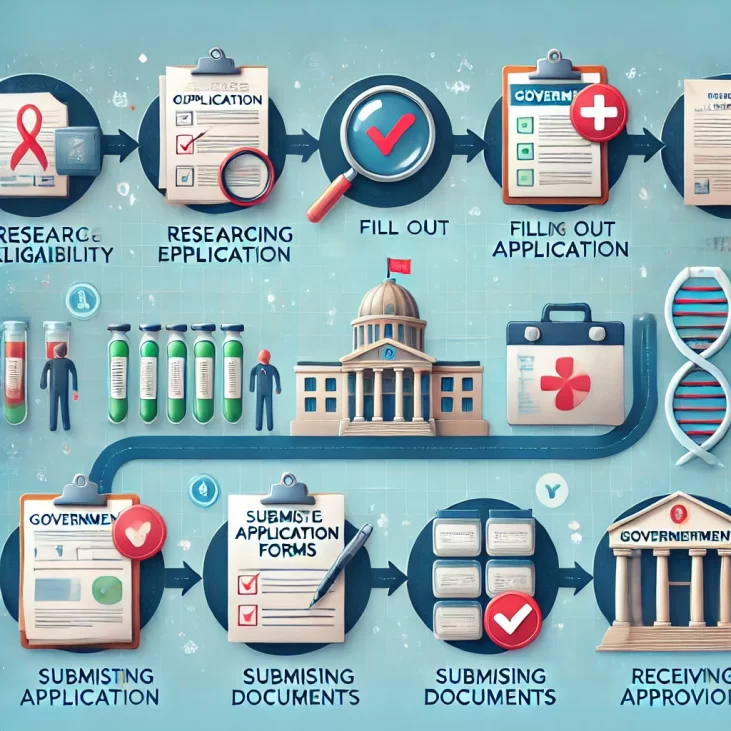
Unlocking Government Funding for Cord Blood Banking
Accessing Grants for Cord Blood Banking
Cord blood banking is a vital practice that preserves a newborn’s umbilical cord blood for potential medical use in the future. However, the costs associated with cord blood banking can be prohibitive for many families. Fortunately, there are government grants available to help alleviate the financial burden of this important service.
Identifying Eligible Grant Programs
The first step in accessing government funding for cord blood banking is to research the various grant programs available. These can include state-level initiatives, as well as federal programs administered by agencies such as the Department of Health and Human Services (HHS) or the National Institutes of Health (NIH).
Some examples of grant programs that may provide funding for cord blood banking include:
- The Newborn Screening Saves Lives Reauthorization Act, which offers grants to support the expansion and improvement of newborn screening programs, including cord blood banking.
- The Stem Cell Therapeutic and Research Act, which provides funding for the operation of the National Cord Blood Inventory, a public bank of donated cord blood units.
- State-level programs, such as the New York State Cord Blood Program, which offers financial assistance for cord blood banking to eligible families.
It’s important to carefully review the eligibility criteria and application requirements for each grant program to ensure that you meet the necessary qualifications.
Preparing a Competitive Grant Application
Once you’ve identified the appropriate grant programs, the next step is to prepare a strong application. This typically involves submitting a detailed proposal that outlines your need for funding, the specific costs associated with cord blood banking, and how the grant would be used to support your family or organization.
Some key elements to include in your grant application:
- A clear explanation of the importance of cord blood banking and its potential medical benefits
- A breakdown of the estimated costs, including fees for collection, processing, and storage
- Information about your financial situation and the need for grant funding
- A plan for how the grant funds will be used to offset the costs of cord blood banking
- Letters of support from healthcare providers or other relevant stakeholders
It’s also crucial to follow all application instructions and submit your materials by the specified deadlines to improve your chances of being awarded the grant.
Ongoing Maintenance and Reporting Requirements
If you are successful in obtaining a government grant for cord blood banking, you’ll likely be required to comply with certain maintenance and reporting requirements. This may include regularly updating the grant-making agency on the status of your cord blood banking activities, as well as providing financial records and other documentation to demonstrate how the funds are being used.
Staying on top of these requirements is essential to maintaining your grant funding and ensuring that you continue to receive the support you need to cover the costs of cord blood banking.
Government grants can be a valuable resource for families and organizations seeking to access the benefits of cord blood banking. By researching eligible programs, preparing a strong grant application, and meeting the ongoing requirements, you can unlock the financial support you need to preserve this important biological resource for the future.
Securing Funding for Cord Blood Banking: A Step-by-Step Guide
Securing funding for cord blood banking can be a crucial step in ensuring the long-term viability and accessibility of this valuable medical resource. Government grants can provide a significant source of financial support, but navigating the application process can be daunting. In this comprehensive guide, we’ll explore the key steps to successfully applying for government grants for cord blood banking.
Identify Eligible Grant Programs
The first step in the process is to research and identify the grant programs that are relevant to your cord blood banking initiative. Look for federal, state, and local government agencies that offer funding opportunities for initiatives related to healthcare, biomedical research, or community-based projects. Some common sources of grant funding for cord blood banking include the National Institutes of Health (NIH), the Centers for Disease Control and Prevention (CDC), and state-level departments of health or public health.
Understand the Eligibility Criteria
Once you’ve identified the potential grant programs, carefully review the eligibility criteria for each one. Ensure that your cord blood banking project aligns with the program’s objectives and that your organization meets the specified requirements. This may include factors such as your legal structure, your track record of successful projects, or the geographic location of your initiative.
Develop a Compelling Grant Proposal
Crafting a strong grant proposal is crucial to securing funding for your cord blood banking project. Start by clearly articulating the need for your initiative and the potential impact it will have on the community or the healthcare landscape. Outline your project’s goals, activities, and expected outcomes, and be sure to highlight how your approach is innovative or unique.
Demonstrate Financial Need and Sustainability
Grant providers will want to see that your cord blood banking project is financially viable and sustainable. Provide a detailed budget that outlines the anticipated expenses, as well as any other sources of funding you have secured or plan to pursue. Explain how the grant funds will be used and how your project will continue to operate after the grant period has ended.
Highlight Partnerships and Collaborations
Many grant programs prioritize initiatives that foster partnerships and collaborations with other organizations. Demonstrate how your cord blood banking project will work with healthcare providers, research institutions, or community groups to maximize its impact and reach. Highlight the unique expertise and resources that each partner brings to the table.
Emphasize the Public Health Benefits
Cord blood banking has significant public health implications, from improving access to life-saving treatments to advancing medical research. In your grant proposal, emphasize the ways in which your project will benefit the broader community, such as by increasing the diversity of the cord blood supply or by providing educational resources to expectant parents.
Follow Submission Guidelines Carefully
Pay close attention to the grant program’s submission guidelines and deadlines. Ensure that your proposal includes all the required components, such as letters of support, financial statements, or project timelines. Double-check your work for accuracy and completeness before submitting your application.
Persistence and Patience
Securing government grants for cord blood banking can be a competitive and time-consuming process. If your initial application is not successful, don’t be discouraged. Review the feedback provided by the grant program and make any necessary adjustments to your proposal. Continue to search for new funding opportunities and be persistent in your efforts.
By following these steps, you can navigate the application process for government grants and secure the necessary funding to support your cord blood banking initiative. With the right approach and a commitment to excellence, you can help ensure that this valuable medical resource remains available and accessible to those who need it.
Maximizing Your Chances of Securing Cord Blood Banking Grants
Cord blood banking is a crucial aspect of healthcare, providing a valuable resource for stem cell therapies and medical research. However, securing the necessary funding to establish or maintain a cord blood banking program can be a significant challenge. Fortunately, there are various government grants available to support these important initiatives. In this article, we’ll explore the strategies and steps you can take to maximize your chances of securing cord blood banking grants.
Identifying Eligible Grant Programs
The first step in securing cord blood banking grants is to identify the appropriate funding opportunities. Government agencies such as the National Institutes of Health (NIH), the Centers for Disease Control and Prevention (CDC), and the Health Resources and Services Administration (HRSA) offer a variety of grant programs specifically designed to support cord blood banking initiatives. Research these agencies thoroughly to understand the specific eligibility criteria, funding priorities, and application requirements for each program.
Crafting a Compelling Grant Proposal
Once you’ve identified the appropriate grant programs, the next step is to craft a compelling grant proposal. The key to a successful proposal is to clearly articulate the importance and impact of your cord blood banking program. Highlight the potential benefits to public health, the advancement of medical research, and the lives that can be saved through the availability of these valuable stem cell resources.
Ensure that your proposal is well-structured, with a clear and concise problem statement, project objectives, and a detailed plan of action. Emphasize the qualifications and expertise of your team, as well as any existing partnerships or collaborations that can strengthen your application. Additionally, provide a comprehensive budget that outlines how the grant funds will be utilized to achieve your program’s goals.
Leveraging Partnerships and Collaborations
Securing government grants often requires demonstrating strong partnerships and collaborations. Consider reaching out to other healthcare organizations, research institutions, or community groups that share your commitment to cord blood banking. By forming strategic alliances, you can showcase the breadth of your support and the collaborative nature of your initiative.
These partnerships can also help you access additional resources, such as data, expertise, and even co-funding opportunities that can enhance the strength of your grant application.
Staying Informed and Persistent
The process of securing government grants can be complex and highly competitive. It’s essential to stay informed about the latest funding opportunities, changes in program requirements, and any relevant deadlines or updates. Set aside dedicated time to continuously research and monitor the grant landscape, and be prepared to revise and resubmit your proposals if necessary.
Persistence is key. Even if your initial application is not successful, use the feedback you receive to refine your approach and try again. Networking with other organizations and attending relevant conferences or events can also provide valuable insights and connections that can improve your chances of securing funding.
Securing government grants for cord blood banking can be a challenging but rewarding endeavor. By identifying eligible programs, crafting compelling proposals, leveraging partnerships, and maintaining a persistent approach, you can increase your chances of securing the necessary funding to support this vital healthcare initiative. With the right strategy and dedication, your cord blood banking program can access the resources it needs to make a meaningful impact on public health and medical research.
Identifying Eligible Cord Blood Banking Programs for Government Grants
Cord blood banking has become increasingly popular in recent years, offering families the opportunity to preserve their newborn’s stem cells for potential future medical use. However, the costs associated with cord blood banking can be a significant barrier for many families. Fortunately, there are government grants available to help offset these expenses. In this article, we’ll explore the process of identifying eligible cord blood banking programs for government grants, ensuring you can make an informed decision and access the financial assistance you need.
Understanding the Basics of Cord Blood Banking Grants
Government grants for cord blood banking can provide substantial financial support to eligible families. These grants are typically offered by state or federal programs and are designed to make cord blood banking more accessible and affordable. By leveraging these grants, families can save thousands of dollars on the initial storage and processing fees associated with cord blood banking.
Identifying Eligible Cord Blood Banking Programs
The first step in accessing government grants for cord blood banking is to identify eligible programs. These programs may have specific criteria, such as income thresholds or residency requirements, that determine eligibility. It’s essential to research the available programs in your state or region and understand their eligibility guidelines.
One of the best resources for finding eligible cord blood banking programs is the Bone Marrow and Cord Blood Donation and Transplantation program website, operated by the Health Resources and Services Administration (HRSA). This website provides a comprehensive list of state-specific programs and their respective eligibility requirements.
Once you’ve identified an eligible cord blood banking program, the next step is to navigate the application process. This may involve submitting various forms, documentation, and financial information to demonstrate your eligibility. It’s crucial to carefully review the application requirements and ensure that you provide all the necessary materials to increase your chances of approval.
In some cases, the cord blood banking facility you choose may be able to assist you with the application process. Many providers have dedicated teams or resources available to guide families through the grant application process, ensuring a seamless experience.
Maximizing Your Chances of Grant Approval
To increase your chances of receiving a government grant for cord blood banking, it’s essential to be proactive and thorough in your application. This may include:
- Gathering all required documentation: Ensure you have all the necessary financial, residency, and medical records ready to submit with your application.
- Adhering to deadlines: Pay close attention to application deadlines and submit your materials well before the due date to avoid any delays.
- Communicating with program administrators: If you have any questions or need clarification on the application process, don’t hesitate to reach out to the program administrators for assistance.
- Exploring alternative funding sources: In addition to government grants, there may be other financial assistance programs or charitable organizations that can help cover the costs of cord blood banking.
By following these steps and diligently navigating the application process, you can increase your chances of securing the financial support you need to make cord blood banking a viable option for your family.
Accessing government grants for cord blood banking can be a game-changer for families who want to preserve their newborn’s stem cells but are concerned about the associated costs. By understanding the eligibility requirements, navigating the application process, and maximizing your chances of grant approval, you can unlock the benefits of cord blood banking while minimizing the financial burden. Remember, taking the time to explore these opportunities can pay dividends in the long run, ensuring your family has access to this valuable medical resource.
Leveraging Cord Blood Banking Grants to Expand Your Operations
Expanding Your Cord Blood Banking Operations with Government Grants
If you’re running a cord blood banking operation, you’re likely always on the lookout for ways to grow and expand your business. One often overlooked opportunity is government grants for cord blood banking. These grants can provide the funding you need to take your operations to the next level.
Identifying Relevant Government Grant Programs
The first step in applying for cord blood banking grants is to identify the relevant programs. There are a variety of state and federal initiatives that offer funding for cord blood banking and related biotechnology research and development. Some key programs to look into include:
- The Regenerative Medicine Innovation Project (RMIP) from the National Institutes of Health (NIH)
- The Biomedical Advanced Research and Development Authority (BARDA) grant program
- State-level stem cell research and biotechnology funding programs
Thoroughly research the eligibility requirements and application processes for these and any other relevant grant opportunities. Pay close attention to deadlines, required documentation, and scoring criteria to give your application the best chance of success.
Crafting a Compelling Grant Proposal
Once you’ve identified the grants you’d like to apply for, it’s time to start working on your proposals. Successful grant applications require a well-organized, persuasive, and detailed proposal. Be sure to:
- Clearly state the problem or need your cord blood banking operation addresses and how the grant funding would enable you to expand your impact
- Provide a detailed overview of your project plan, including specific objectives, activities, and a timeline
- Highlight your team’s expertise and experience in cord blood banking and biotechnology
- Develop a comprehensive and realistic budget that justifies how the grant funds will be utilized
- Include letters of support from relevant stakeholders, such as medical professionals, research partners, or community organizations
Leveraging Partnerships and Collaborations
Many government grant programs prioritize projects that involve partnerships and collaborations. Consider reaching out to universities, research institutions, hospitals, or other cord blood banking organizations to explore potential collaborative grant opportunities. By bringing together complementary expertise and resources, you can create a more compelling and competitive grant application.
Ongoing Grant Management and Reporting
If your application is successful and you receive grant funding, your work is not done. Effective grant management is crucial to ensuring you meet all requirements and maximize the impact of the funding. This includes:
- Carefully tracking and documenting how grant funds are spent
- Providing regular progress reports and financial statements to the grantor
- Communicating proactively with the grant administrator about any changes or challenges
- Preparing for and cooperating with any required audits or site visits
By staying on top of grant management, you can demonstrate the success of your project and potentially open the door for future funding opportunities.
Government grants can be a valuable source of funding to help cord blood banking operations expand their reach and impact. By identifying relevant programs, crafting compelling proposals, leveraging partnerships, and diligently managing grant funds, you can unlock the resources you need to take your business to new heights. Dedicating the time and effort to the grant application process can pay dividends for the long-term growth and sustainability of your cord blood banking enterprise.
Conclusion
Securing government grants for cord blood banking can be a game-changer for your operations. By unlocking this valuable source of funding, you can not only expand your reach and capabilities but also ensure that more families have access to this crucial medical resource. Throughout this article, we’ve explored the key steps to navigating the application process, maximizing your chances of success, and identifying the right programs to target.
The first critical step is understanding the landscape of government funding for cord blood banking. This means researching the various grant opportunities available, their eligibility criteria, and the specific requirements for each application. By familiarizing yourself with these details, you can tailor your approach and increase your chances of securing the much-needed financial support.
Navigating the application process can be daunting, but with the right strategies, you can streamline the experience and increase your chances of success. From crafting a compelling narrative that showcases the impact of your cord blood banking program to ensuring that all the necessary documentation is in order, each step in the application process deserves careful attention.
Maximizing your chances of securing cord blood banking grants is all about positioning your organization as a standout candidate. This may involve highlighting your track record of success, demonstrating the unmet need in your community, or showcasing innovative approaches that set you apart from the competition. By presenting a strong, well-rounded case, you can increase the likelihood of your application being selected.
Identifying eligible cord blood banking programs for government grants is crucial, as these funding opportunities are often tailored to specific initiatives or target populations. By researching the available grants and aligning your program’s objectives with the grant’s focus areas, you can increase your chances of finding the right fit and submitting a successful application.
Leveraging cord blood banking grants to expand your operations can have a transformative impact on your organization and the communities you serve. With the additional funding, you can invest in infrastructure upgrades, expand your donor pool, enhance research and development efforts, or implement innovative outreach and education programs. By strategically utilizing these grants, you can amplify your impact and ensure that more families have access to the life-saving potential of cord blood.
The journey to securing government grants for cord blood banking may seem daunting, but with the right approach and a deep understanding of the process, the rewards can be immense. By mastering the strategies outlined in this article, you can unlock a valuable source of funding, expand your reach, and ultimately make a lasting difference in the lives of those you serve. Seize this opportunity, and watch your cord blood banking program soar to new heights.

